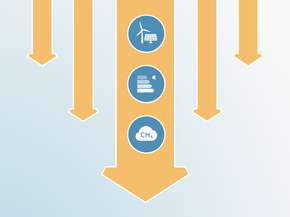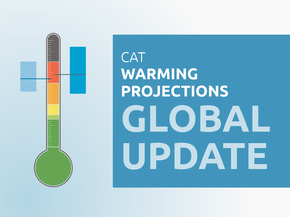Assumptions
Historical emissions
For historical data, GHG inventory data submitted to the UNFCCC accessed via the UNFCCC data portal was used for 1990 and 1994 (UNFCCC, 2019) and the National GHG Inventory Report published by the Ministry of Forestry, Fisheries and the Environment in 2022 was used for 2000 to 2020 (DFFE, 2023), with linear interpolation between 1990–1994 and 1994–2000. We used multiple sources because no single source provides a full data set from 1990-2021.
For the years 2021 and 2022, we use growth rates from PRIMAP historical emissions applied to the 8th National Inventory Report published by the South African government in 2023 (Gütschow & Pflüger, 2023b; South African Government, 2023a). This inventory report did not include report emissions for 2022. Since updating the policy projections with this data, the South African government has published a new inventory report with their Biennial Transparency Report in late 2024. As the differences are small with the interpolated 2022 estimates, this source is not yet incorporated into historical emissions or policy projections and will be incorporated future updates.
It is important to highlight that the University of Cape Town’s technical emissions scenario analysis which informed the 2021 NDC update found significantly lower emission levels compared to the 2023 National GHG Inventory report. This was due to the use of different methodologies and data sources (Marquard et al., 2021). For 2017, for example, there is a 15 MtCO2e difference between both estimates. We currently rely on official estimates provided by the Government of South Africa as explained above.
NDC targets and other targets
In its 2021 updated NDC, South Africa provides an absolute emissions level in the target range 350–420 MtCO2e including LULUCF for 2030 (South African Government, 2021). Assuming LULUCF remains at the average level over 2011–2020 (-17 MtCO2e), this NDC target range translates to emission levels in 2030 of between 367–437 MtCO2e excluding LULUCF
It is unclear which GWP values have been used to calculate the target range of the updated NDC of 2021. The NDC states that its targets are based on the latest inventory report, which uses SAR values, and that the country would transition to using AR5 in 2024.
In its first NDC of 2016, South Africa’s target range was calculated using AR4 values. As the lower bound of the target range for 2025 is 398 MtCO2e (incl. LULUCF) in both the first NDC of 2016 and the updated NDC of 2021, we assume that South Africa has continued to use AR4 values for these figures, notwithstanding the values used in its inventory report. Furthermore, the comparison that “the upper end of the target range in 2025 has been reduced by 17%, and the upper end of the target range in 2030 has been reduced by 32%, and the lower range by 12%” (South African Government, 2021) points to comparing both target ranges in AR4.
Current policy projections
Lower bound projection
The lower bound of the current policy projections is based on a combination of the IEA World Energy Outlook (WEO) 2020 for CO2 emissions from fuel combustion (IEA, 2020) and non-CO2 emissions from the US EPA (US EPA, 2019). For other CO2 emissions (fugitive CO2 emissions and process emissions), we used historical data from the National GHG Inventory Report extended to 2021 with growth rates from PRIMAP and assume a direct correlation to emissions from coal-fired power plants afterwards (DFFE, 2023; Gütschow & Pflüger, 2023a).
The WEO2020 Stated Policies Scenario for CO2 emissions from fuel combustion assumes full implementation of the 2019 Integrated Resource Plan with COVID-19 delay. The 2019 Integrated Resource Plan is outdated as of early 2025 and actual power plant capacities have diverged from the expected roadmap. However, the government has not presented a finalised updated national energy plan as the time of this analysis. For this reason, the analysis continues to use the WEO2020 Stated Policies Scenario.
For non-CO2 emissions, we applied the growth rate from (US EPA, 2019) projections until 2030 to historical emissions. For CO2 process emissions and fugitive CO2 emissions, historical emissions data from PRIMAP (Gütschow & Pflüger, 2023a) was used to check the correlation to emissions from coal-fired power plants. For projections, CAT assumes that this correlation will continue, meaning that we assume CO2 process emissions to develop with the same trend as the CO2 emissions from coal fired power plants in our current policy projections.
Upper bound projection
The upper bound of the current policy projections is based on the ‘existing policies scenario with reference growth rate’ by the University of Cape Town’s technical emissions scenario analysis to inform the 2021 NDC update (Marquard et al., 2021). The ‘existing policy scenario’ assumes the full implementation of the IRP2019, a new world-scale crude refinery coming online in 2028 in line with government procurements, other crude refining capacity and coal-to-liquids capacity available until 2050, and the forecasted modernisations introduced by the 1st and 2nd National Waste Management Strategies.
We harmonise the scenario’s growth rates for total emissions excluding land use emissions to the latest historical datapoint of 2021. This harmonisation process results in significantly higher final estimates for 2030 than assumed by the University of Cape Town’s ‘existing policies scenario with reference growth rate’ (502MtCO2e compared to 479 MtCO2e excluding LULUCF). Note that the University uses GWP values from the IPCC’s Second Assessment Report (SAR), while the CAT uses GWP values from the Fourth Assessment Report (AR4).
Planned policy projections
The planned policy projections is based on the ‘planned policies scenario with reference growth rate’ by the University of Cape Town’s technical emissions scenario analysis to inform the 2021 NDC update (Marquard et al., 2021). Beyond the measures included under the ‘existing policy scenario’ (see section above), the ‘planned policy scenario’ assumes the full implementation of recently announced IRP2019 expansion plans, the Green Transport Strategy, the draft post-2015 National Energy Efficiency Strategy, and the carbon tax.
We harmonise the scenario’s growth rates for total emissions excluding land use emissions to the latest historical datapoint of 2021. This harmonisation process results in significantly higher final estimates for 2030 than assumed by the University of Cape Town’s ‘existing policies scenario with reference growth rate’ (404 MtCO2e compared to 383 MtCO2e excluding LULUCF). Note that the University uses GWP values from the IPCC’s Second Assessment Report (SAR), while the CAT uses GWP values from the Fourth Assessment Report (AR4).
Net-zero target
The South African government provides no underlying assumptions on its 2050 net-zero CO2 target as part of a visionary statement in its LTS (South African Government, 2020b). For this reason, we assumed that CO2 emissions will decline at a linear rate between 2030 and 2050 to balance LULUCF sinks in 2050. We assume that non-CO2 emissions will decline at a linear rate between 2030 and 2080 in line with the IPCC SR1.5 pathways. This would result in estimated residual emissions of 80 MtCO2e in 2050.
Global Warming Potentials values
The CAT uses Global Warming Potential (GWP) values from the IPCC's Fourth Assessment Report (AR4) for all its figures and time series. Assessments completed prior to December 2018 (COP24) used GWP values from the Second Assessment Report (SAR). The ‘NDC targets’ section above outlines the uncertainties on GWP assumed for the updated NDC target range.
Further analysis
Latest publications
Stay informed
Subscribe to our newsletter




